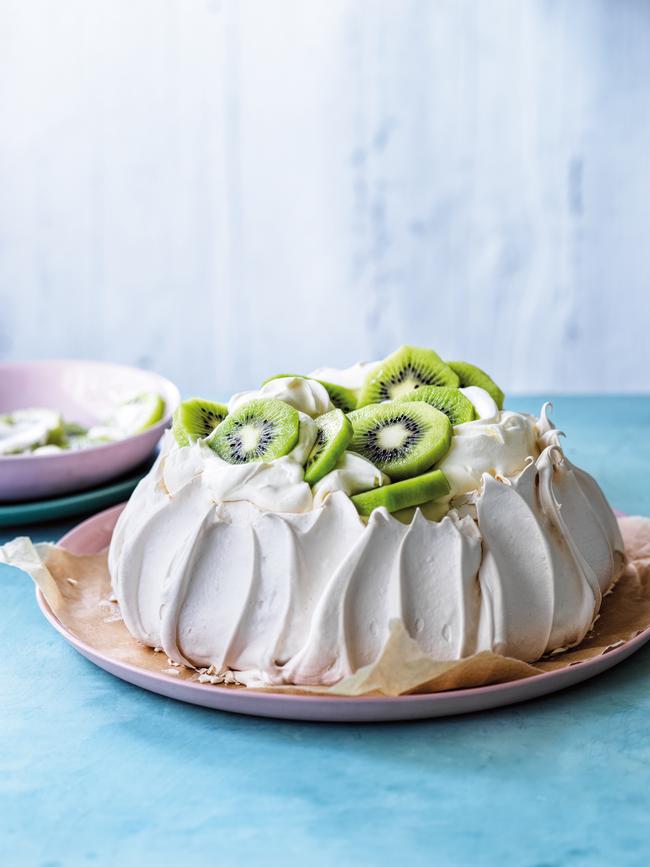Summer cookbook: Matt Preston’s pavlova
No last meal of mine is ever going to be one dish… but any iteration of my last meal has to have a pavlova in it. And it needs to be this one.

No last meal of mine is ever going to be one dish, but any iteration of my last meal has to have a pavlova in it. And it needs to be this pavlova, where the only New Zealand thing about it is the kiwifruit on top.
Pavlova made an instant impression on me when I had it as a kid. I can clearly remember the first one I tried. It was made by an Aussie dentist called Ashley Burt who had a kid at my brother’s kindy. It was topped with pineapple, which was a racy decision but perfectly Australian.
I remember being obsessed with the chewiness of the meringue, which I was told was down to the use of vinegar when in fact it was probably under-baked when it was a little humid; the vinegar helps the meringue’s stability. But I didn’t care. Growing up in a country where meringues were usually just two bites, the size was impressive to a 13-year-old boy, as were the billows of whipped cream. Basically, it suggested it was what an Eton mess looked like before someone dropped it.

By the way, the name pavlova was coined for the meringue cake made by Burt Sachse, who was head chef at Perth’s Esplanade Hotel in the 1920s.
Yes, it’s true that Russian prima ballerina Anna Pavlova toured Australia and New Zealand in 1926. Both tours were the biggest cultural events in those years. Many New Zealanders will tell you that pavlova was created around the same time by an unnamed Wellington chef who decorated the dessert with kiwifruit to replicate the green roses on her tutu for one of her nine performances in Wellington, but scanning the press shots of the dancer on stage there are no green silk roses to be seen.
It just another example of New Zealand trying to own our pav (which probably existed first in Prussia as a cream and fruit-topped meringue torte).
University of Otago emeritus professor Helen Leach dismisses this version of events in her book The Pavlova Story: A Slice of New Zealand’s Culinary History, as she could find no evidence to support the claim.
Leach’s research, however, did find three desserts from this period named after Pavlova.
One was a 1926 layered jelly that features neither cream nor meringue, in a New Zealand recipe pamphlet from the Davis Gelatine Corporation.
The closest thing to a Kiwi recipe for pavlova is for pavlova cake – meringue that is split and filled with cream and preserved fruit, like a meringue version of a Victoria sponge.
It was a recipe for one of these meringue cakes by Miss Emily Futter of Double Bay that inspired both Australia’s and New Zealand’s pav. It was published in The Australian Woman’s Mirror magazine in 1935, and was the recipe that West Australian chef Sachse was seeking to improve upon when he created his cream and fruit-topped dessert and called it simply pavlova.
The Esplanade Hotel where Sachse worked was where Anna Pavlova stayed when she returned to Australia in 1929, and Sachse’s version of the pavlova is the one that went on to become a worldwide hit.
So respect to Miss Futter of Sydney’s Double Bay.
Pavlova
Serves 10
Prep 20 minutes (plus cooling) Cook 1 hour 30 minutes
INGREDIENTS
● 6 egg whites, at room
temperature
● ½ teaspoon cream of tartar
● 1½ cups (330g) caster sugar
● 1 teaspoon vanilla extract
● 1½ cups (375ml) thickened cream
● 5 kiwifruit, peeled, sliced (see tip)
METHOD
Preheat the oven to 150C (130C fan-forced). Draw a 22cm circle on a piece of baking paper. Turn the paper pencil-side down on to a large baking tray.
Use electric beaters (preferably a stand mixer so it’s easy to add the sugar) to whisk the egg whites and cream of tartar in a large clean, dry bowl until firm peaks form.
Gradually add the sugar, 1 tablespoon at a time, beating constantly, until the sugar dissolves and the mixture is thick and glossy. When the meringue is glossy and you can rub a little between your fingers without feeling the grain of the sugar, beat in the vanilla.
Spoon the meringue mixture on to the paper, using the drawn circle as a guide to make a neat round. Use a flat-bladed knife to shape the sides of the meringue to make furrows by sweeping upwards.
Bake for 10 minutes, then reduce the oven temperature to 110C (90C fan-forced).
Bake for a further 1 hour 20 minutes or until the meringue is crisp and dry. Turn the oven off. Leave the pavlova in oven, with the door closed, to cool completely.
Use electric beaters to whisk the cream in a bowl until firm peaks form. Top the pavlova with cream and heaps of kiwifruit. We can’t take everything from our Kiwi friends.
TIP: Yes, you can top the pav with strawberries, raspberries, pitted cherries, pith-free orange segments spritzed with rosewater, and so on – or, use three mangoes and two passionfruit, if you want to be parochially Aussie. You could even use Chinese gooseberries – another name for kiwifruit.

To join the conversation, please log in. Don't have an account? Register
Join the conversation, you are commenting as Logout